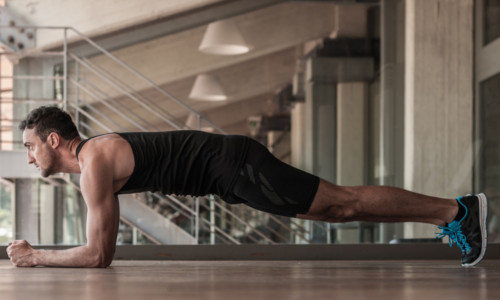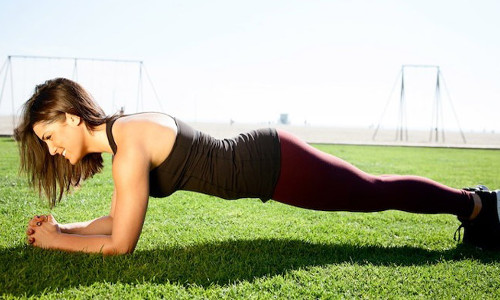The Perfect Way to Plank
Author

A keen runner, skier and nuts about cycling. Karl lives in Cumbria, where he loves encouraging his two children to follow in his outdoor lifestyle. Whilst out and about keeping active, Karl keeps a diary and shares it with Outdoor Look.
 Most fitness enthusiasts believe that the plank is the ideal way for achieving solid abs and strengthening your core. Yes, that’s all true. But, planking also engages shoulders, spine and hips and all the muscles in those regions, building head-to-toe strength and stability. While you are doing plank, all the muscles of your body are fighting against gravity allowing you to maintain your position.
Most fitness enthusiasts believe that the plank is the ideal way for achieving solid abs and strengthening your core. Yes, that’s all true. But, planking also engages shoulders, spine and hips and all the muscles in those regions, building head-to-toe strength and stability. While you are doing plank, all the muscles of your body are fighting against gravity allowing you to maintain your position.
How to do a Standard Plank
- Place your palm on the floor, like you do for a push-up, directly under your shoulders.
- Extend your legs to the fullest extent, directly behind you, forming a straight line from head to toe.
- Look on the floor just about a foot in front of your palms to get your neck in a neutral position.
- Make sure your back is straight; if not then adjust your position.
- Keep breathing and hold the position for as long as you can.
As you keep doing plank in your daily routine, your muscles will start getting used to the force exerted on them by gravity. Soon, you will feel the need to ramp up the difficulty level. Here’s what you can do:
Side Plank
This variation of the plank engages the side muscles of the core.
- While doing the standard plank, rotate your body in one direction till your legs are stacked on top of each other.
- Raise one hand over your shoulders so that both your hands form a straight line.
- Hold your position for a certain interval, say 20 seconds, then rotate your body to attempt plank on the other side
 Single-Leg Plank
Single-Leg Plank
This variation increases the load on the core by removing a point of contact with the ground.
- Position yourself for a standard plank and lift one leg a few inches from the ground.
- Hold your position for one breath, lower your leg and repeat the procedure with the other leg.
Single-Arm Plank
This variation increases the load on the core as is the case with Single-Leg Plank
- Attain the standard plank position and lift one hand to get into a straight line with the rest of your body.
- Hold your position for one breath, lower your hand and repeat the procedure with the other hand.
Walking Plank
This variation stretches your hands and legs and put extra load on the core.
- When in standard plank position start moving your legs towards your hands without bending them.
- Then move your hands in small steps until you reach the standard plank position and repeat the process.
Up and Down Plank
This variation put extra load on your forearms and shoulders in addition to your core.
- Keep your core stable in the standard plank position and lower one forearm to the ground and then the other forearm.
- Now lift one arm and then the other to get into the standard plank position and keep repeating the process.
If you are just getting started on your fitness regime, getting the standard plank can be a little tough. Here’s what you can do:
Forearm Plank
Instead of placing your palms on the ground, make contact with the ground using your forearms and put the rest of your body in the same position as that of the standard plank. This variation lowers the load on your arms.
Knee Plank
Rest your knees on the ground and place the rest of your body in a position similar to the standard plank. This position is a bit easier to hold as your knee shares the load with your core.
Author

A keen runner, skier and nuts about cycling. Karl lives in Cumbria, where he loves encouraging his two children to follow in his outdoor lifestyle. Whilst out and about keeping active, Karl keeps a diary and shares it with Outdoor Look.
Categories
- Sport (28)
- Product Reviews (3)
- Team Outdoor Look (7)
- Mike Wild (2)
- Mike Payton (2)
- Suse Hammond-Pears (3)
- Snowboarding (12)
- Latest Offers (105)
- Shop Talk (1)
- Competitions (7)
- Walking (413)
- Lifestyle Fashion (8)
- Travel (86)
- Kit Guides (176)
- Workwear Clothing (6)
- Safety Workwear (4)
- Health/Fitness (289)
- Skiing (91)
- Great Outdoors (1316)
- Cycling (92)
- January 2025
- December 2024
- November 2024
- October 2024
- September 2024
- August 2024
- July 2024
- June 2024
- May 2024
- April 2024
- March 2024
- February 2024
- January 2024
- December 2023
- November 2023
- October 2023
- September 2023
- August 2023
- July 2023
- June 2023
- May 2023
- April 2023
- March 2023
- February 2023
- January 2023
- December 2022
- November 2022
- October 2022
- September 2022
- August 2022
- July 2022
- June 2022
- May 2022
- April 2022
- March 2022
- February 2022
- January 2022
- December 2021
- November 2021
- October 2021
- September 2021
- August 2021
- July 2021
- June 2021
- May 2021
- April 2021
- March 2021
- February 2021
- January 2021
- December 2020
- November 2020
- October 2020
- September 2020
- August 2020
- July 2020
- June 2020
- May 2020
- April 2020
- March 2020
- February 2020
- January 2020
- December 2019
- November 2019
- October 2019
- September 2019
- August 2019
- July 2019
- June 2019
- May 2019
- April 2019
- March 2019
- February 2019
- January 2019
- December 2018
- November 2018
- October 2018
- September 2018
- August 2018
- July 2018
- June 2018
- May 2018
- April 2018
- March 2018
- February 2018
- January 2018
- December 2017
- November 2017
- October 2017
- September 2017
- August 2017
- July 2017
- June 2017
- May 2017
- April 2017
- March 2017
- February 2017
- January 2017
- December 2016
- November 2016
- October 2016
- September 2016
- August 2016
- July 2016
- June 2016
- May 2016
- April 2016
- March 2016
- February 2016
- January 2016
- December 2015
- November 2015
- October 2015
- September 2015
- August 2015
- July 2015
- June 2015
- May 2015
- April 2015
- March 2015
- February 2015
- January 2015
- December 2014
- November 2014
- October 2014
- September 2014
- August 2014
- July 2014
- June 2014
- May 2014
- April 2014
- March 2014
- February 2014
- January 2014
- December 2013
- November 2013
- October 2013
- September 2013
- August 2013
- July 2013
- June 2013
- May 2013
- April 2013
- March 2013
- February 2013
- January 2013
- December 2012
- November 2012
- October 2012
- September 2012
- August 2012
- July 2012
- June 2012
- May 2012
- April 2012
- March 2012
- February 2012
- January 2012
- December 2011
- November 2011
- October 2011
- September 2011
- August 2011
- May 2010
- April 2010
- March 2010
- February 2010
- January 2010
- November 2009
- October 2009
- September 2009
Submit a Comment